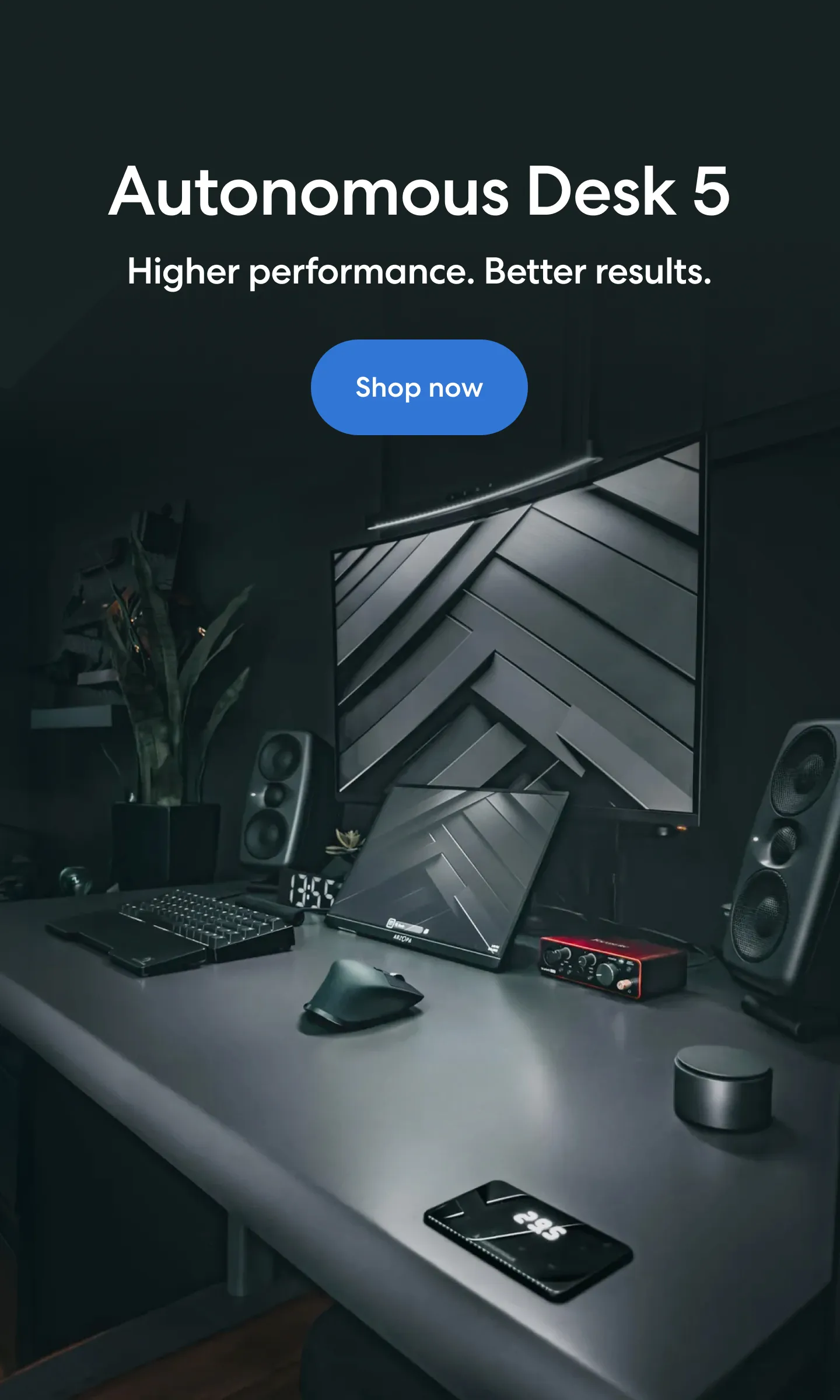.webp)
5 Ways to Improve Lighting Ergonomics and Stay Productive
Table of Contents
Ergonomics is crucial to the modern workplace. While most companies and employees today are more educated on office well-being, a key component of an ergonomic workplace often forgotten is lighting.
Ergonomic lighting is essential for workplace well-being, and it plays a crucial role in preventing Computer Vision Syndrome (CVS). According to a 2014 survey, 60% of adults between the ages of 20 and 50 have experienced CVS symptoms. These symptoms include blurred vision, dry eyes, and headaches.
Improper lighting, whether it’s too little or too much lighting, contributes significantly to digital eye strain. Appropriate lighting, without shadows or glare, can reduce eye fatigue and headaches. Poor lighting—whether it is too dim or overly bright—can lead to discomfort, making it difficult for your eyes to adjust Thus, if you often experience dry eyes, blurred vision, or even headaches after working on your computer, optimizing the lighting ergonomics in your office or at your desk can help ease these symptoms.
What Is Lighting Ergonomics?
Lighting ergonomics is the relationship between an individual and the source of light. It has a tremendous impact on productivity, workplace well-being, and preventing CVS.
Many offices have overhead lighting fixtures as the primary source of light; this causes glare or shadows. The situation becomes even worse if there’s flickering or insufficient illumination. Also, poor lighting can cause improper contrast (low light from the room and bright light from the computer screen), poor distribution of light, and wrong color temperature, which causes eye strain and fatigue.
That’s when lighting ergonomics comes in handy to provide the right amount of light when and where needed. The right balance of light, especially with the appropriate color temperature, can help prevent fatigue and improve the overall atmosphere.
Why Is Lighting Ergonomics Important?
As mentioned, lighting ergonomics is essential in designing offices and homes. Poor lighting can result in a variety of issues, including:
- Low productivity
- High employee error rates
- Eye fatigue
- Low focus
- Inability to select and match the correct colors
- Headaches
- Low worker morale
- General sickness
Poor lighting can significantly affect your performance and overall well-being. Plus, the wrong color temperature can affect your mood and emotions, affecting your bottom line. That’s why you need to improve the lighting ergonomics in your environment to maintain a healthy environment, as well as to boost your productivity.
Tips For Optimizing Good Lighting Ergonomics
Here are several tips to help you optimize lighting ergonomics in any environment, whether it's your home or your office:
1. Ensure Proper Adequate Lighting
One of the most crucial aspects of ergonomic lighting is ensuring that your workspace at home or office has sufficient light. Poor lighting forces your eyes to work harder, causing strain and fatigue.
Ideally, a workspace should have 300–500 lux of illumination, which is the measurement of light intensity. It’s also important to take advantage of natural light whenever possible, as studies show that workers with access to natural light are generally more alert and have better sleep quality.
Additionally, using higher-lumen bulbs provides brighter lighting, making the space more comfortable to work in. Also, don’t forget that the closer the light source is to an object (besides focus and angle), the higher the lux level, as the light is more concentrated.
2. Remove unwanted dark spots and shadows
Over-reliance on direct lighting leads to dark spots and shadows around your office and home spaces, which is another common type of improper lighting ergonomics that causes eye fatigue and headaches. Using a mixture of direct and indirect lighting can eliminate unwanted dark spots and shadows. These factors can make it harder to focus and increase eye strain.
To solve this, use a combination of direct and indirect lighting.
Direct lighting is when most of the light spread of a fixture falls on a specific area or object. These include task, spotlight, and certain overhead lights with partial shades that cast the light downwards.
Indirect lighting entails the light spread that falls outside of the direct scope and lights objects other than those in the direct illumination spread. Indirect lighting also applies to light fixtures, which cast light upwards in an upright design. They naturally cast the light upwards to the ceilings and walls instead of a specific object.
This balanced approach ensures that your workspace at any environment is well-lit and comfortable.
3. Reduce Direct And Indirect Glares
Glare is caused by a bright source of light that directly enters your line of sight or indirectly by reflecting off glossy surfaces. Glare can strain your eyes because it impedes your ability to discern anything but the brightest light properly.
Bright areas, such as windows, ceilings, and luminaries, which are directly in the field of view, cause direct glare. The light that’s reflected to the eye from surfaces, including the task area, which is in the visual field causes indirect glare.
Glare causes eye fatigue because it forces your eyes to adjust to its brightness level, making dull areas in your workspace hard to see.
To reduce glare, consider the following tips:
- Place your desk and chair 90 degrees from large windows to reduce glare from the sun.
- Add blinds on windows. For East/West-facing windows, use vertical blinds to block out sunlight based on its position throughout the day. And for North/south-facing windows, use horizontal blinds to block general sunlight.
- Regulate your monitor brightness to match the brightness of the area directly behind it. Using a program, such as f.lux can help.
- Place your lighting fixtures strategically to avoid direct glare from overhead lights.
- Use several lower-intensity light fixtures instead of a single high-intensity one.
- Use conventional fluorescent light fixtures with diffusers to soften the light intensity.
- Use monitor privacy filters to filter out blue light and glare at the same.
- Cover your bulbs with shades to soften and cast the light away from your eyes.
4. Adjust Color Temperature Based On Mood And Task
Lighting ergonomics not only helps in mitigating physical health issues, but it can also improve your mood and productivity.
Color temperature refers to how “cool” or “warm” the light is, and it’s measured in Kelvin (K). Warmer color temperatures facilitate sleepiness, while cooler color temperatures promote productivity by 19.4%.
Studies also show that cooler color temperatures improve mood and alertness, as well as mental health.
5. Ensure Adequate Contrast Between Background And Foreground
Contrast is the relationship between an object and its background in terms of brightness or color. Poor color contrast forces your eyes to work harder to make sense of objects in the foreground.
To improve lighting ergonomics, the first thing you need to focus on is, color contrast, especially on the monitor screen where most of us spend a lot of time.
As you can see, when there’s an insufficient color distinction between the foreground and background, it’s hard to see the former.
Adjust your monitor to find the right color contrast that provides the best visibility.
Lighting contrast is the next thing to consider when optimizing for good lighting ergonomics. To ensure good lighting contrast, you should avoid the big variation in lighting between the foreground and background. If, for example, you’ve tried to use your phone outside during the day, then you’ve experienced poor lighting contrast, which makes it hard to see what’s on your phone.
To fix poor lighting contrast in your office, look for big differences in brightness levels. Start by making your background area uniform in brightness, then your immediate workspace brighter.
Final Thoughts
To dim or not to dim? Use lamps with adjustable brightness because they allow you to reduce the light to the perfect level of ambiance. Also, using an ergonomic desk lamp at your desk improves the ability to adjust the brightness. However, if you’re using an LED bulb, make sure that it’s marked as dimmable.
If your desk lamp doesn’t have dimmable brightness, angle the light head; this reduces brightness as it changes the direction of the light.
Optimizing your lighting can significantly improve comfort and productivity, creating an environment where you can work efficiently, whether at home or in the office.
Spread the word
.svg)







